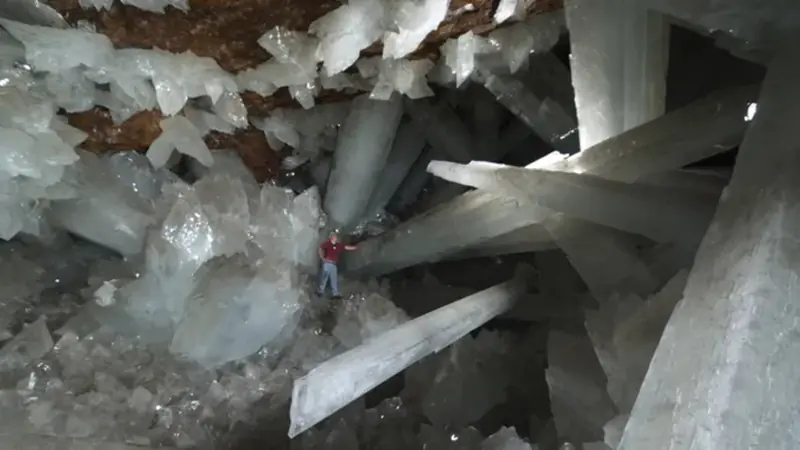This underground cave, filled with gigantic selenite crystals—a variety of gypsum—is truly one of a kind. It’s also known as the “Cave of Crystals” or the “Sistine Chapel of Crystals.” “This is the Sistine Chapel of Crystals,” declared Juan Manuel García-Ruiz, a geologist with the Spanish National Research Council (CSIC) and the University of Granada, in a 2007 interview with National Geographic. Since then, the name has gained traction in the scientific community.
The cave lies 300 meters beneath the town of Naica in the Mexican state of Chihuahua. Scientists explain that the town is situated on an ancient fault line, with a magma chamber located beneath the cave. For millions of years, the cave was filled with mineral-rich solutions at temperatures between 54-58 °C, creating ideal conditions for crystal growth. These crystals are massive, resembling tree trunks, with some reaching lengths of 11 meters and widths of four meters. The largest weigh around 55 tons, making them the most massive crystals ever found on Earth.

What else is known about this cave? The Cave of Crystals, shaped like a horseshoe, is connected to a lead, zinc, and silver mine—the Naica mining complex—which was flooded about ten years ago. The cave was accidentally discovered in 2000 by miner brothers named Sanchez, who were digging a new side tunnel for ventilation. Upon entering the cave, they were awestruck by the breathtaking sight that unfolded before them. The miners saw a cavity in the limestone rock, intersected by enormous, milky-white crystals in various directions. It was later revealed that these crystals were made of selenite—a sulfate mineral formed from salts dissolved in groundwater. It’s so soft that it can be scratched with a fingernail, as reported by Live Science.
Over the years, several crystal-filled caves have been discovered during mining operations in Naica, including the Cave of Swords, which is lined from floor to ceiling with dagger-like crystals. However, the Cave of Crystals is undoubtedly the largest, measuring 110 meters in width and boasting a maximum volume of 6,000 cubic meters—more than double that of an Olympic swimming pool.
While the conditions in the cave are optimal for crystals, they are deadly for humans. This explains another name that has emerged. With temperatures hovering around 58 °C, it’s extremely hot inside, and humidity levels reach 90-100%. Consequently, studying the cave is quite challenging. Even with specialized equipment, a researcher can only stay inside for about 20 minutes. Without gear, a visit lasts a maximum of 10 minutes. Navigating between the enormous crystals is perilous, as they are incredibly slippery. Nevertheless, scientists remain determined to explore the Cave of Crystals as thoroughly as possible. Biologists, in particular, speculate that the liquid filling its tiny cavities may harbor ancient microorganisms of unknown species.
